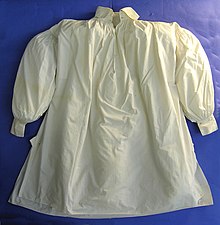Shirt

The shirt or blouse is a garment, both formal and informal, made of fabric that covers the torso and arms, usually having sleeves, a collar, and buttons on the front. The term blouse refers to the shirt used by women, children and also when it is used in different tasks by men and women.
Etymology of the term shirt
The word "shirt" It takes its name from the late Latin camisia.
The origin of the word "camisia" it is controversial; according to Etymologiarum libri XX, written by Saint Isidore of Seville, it comes from the fact that it was used to sleep in bed (in Latin, camis); but according to Saint Jerome, the word "camisia" It has Celtic or Germanic origin.
History of the shirt
The shirt in Egypt, Rome and the Middle Ages
The history of the shirt can date back to 1500 BC. C., when the Egyptians, both men and women, adopted the kalasiris, a rectangle-shaped piece of thin linen fabric with an opening to insert the head. During the Roman Empire, sleeves were added to that piece of fabric and it was called a manicata tunic. In the Middle Ages and until the XIV century, the shirt was a white undergarment whose function was to protect the skin from other rougher outer fabrics. As it was considered underwear, it lacked buttons to close it and its mission was to cover the body before putting on the jacket or sweater.
Shirts and their use in papermaking
The widespread use of shirts in the 14th century allowed there to be enough rags from old shirts to make paper at affordable prices. The invention of the printing press, together with the production of low-priced paper, allowed the book to emerge as an affordable product, and not as an ancient curiosity.
The shirt in the Renaissance
It will be in the Renaissance when the shirt becomes widely used. The Italian fashion of the time widened the sleeves allowing part of it to peek out at elbow height. Later, the Germans incorporated slashing, a fashion originating in Switzerland that consists of tearing the surface of outer garments, revealing what is underneath. In the XVI century, square necklines will be incorporated:
French Revolution
During and after the French Revolution, towards the end of the 18th century, a major change occurred in men's clothing. The clean lines appear, characteristic of English clothing, which will imply the loss of the previous ornamentation. The glamor moves to the accessories of the scarf or tie.
Early 19th century

As military garments became shorter until they ended up in the current jacket or blazer and vest, the shirt was left exposed, which led to the need to finish it off with meaningful cuffs and collars.
The white shirt, for many people, was a symbol of aristocracy, because they were the ones who used to keep them clean. At the beginning of the 21st century, a white shirt continues to maintain a character of distinction for many; but it is also because white is a neutral color that is very easy to combine with the different colors that suits and, above all, ties can provide.
19th to 21st centuries - Shirt textile industry
The manufacture of shirts had a great boom at the end of the 19th century in the United States, taking advantage of the emigration that came from Europe moved seamstress work that was traditionally performed at home to workshops and factories. The manufacture of the garment, shirt or blouse, had spectacular growth by replacing other more traditional clothing items. In the development of the textile industry, events of great importance occurred: the Strike in the New York shirt factories in 1909 and the subsequent Fire in the Triangle Shirtwaist factory in New York in 1911, which led to some improvements in working and health conditions. security of the textile industry. In 2013, already in the 21st century, the building in Savar where numerous clothing factories were located collapsed. that supplied products to numerous commercial companies around the world. In Mexico, the existence of Maquiladoras has allowed the country to achieve economic development and the creation of employment in the female sector, but at the cost of difficult working conditions - long hours and low salaries.
Types of shirts
In principle, the first differences are marked by their use. Thus, there are:
- Informal walk: the one designed to be lucid alone or under sports garments and as such they are not designed to look with tie and usually have buttons on the neck.
- Unisex shirt: the one used equally in both men and women, regardless of gender. Usually they are garments with a slightly more lazy pattern, so adapt to many more bodies and silhouettes.
Political use of the term shirt

The display of the shirt as a paramilitary uniform of a certain color was a distinctive sign of the fascisms of the 1920s and 1930s, starting with:
- Italian black shirts (which in turn took the idea of the red shirts that pushed the Italian Unification to the orders of Garibaldi). There. blackshirts in England and black shirts in German Nazi SA and Finland.
- Straight walks (Nazis in Germany)
- Blue shirts (Canada, China, Spain, Ireland and Portugal)
- Green Shirts (Brazil, Hungary, Romania)
- Gold shirts (Mexico)
- Silver shirts (United States)
Gallery
Hawaiian Shirt
Guayabera
Leather shirt
Truck, cowgirl
Embroidered shirt
Contenido relacionado
Cuff (clothing)
Clothing in Ancient Greece
Military panty




